Health Care - Diabetic Ketoacidosis
VerifiedAdded on 2022/08/25
|7
|1587
|21
AI Summary
Contribute Materials
Your contribution can guide someone’s learning journey. Share your
documents today.
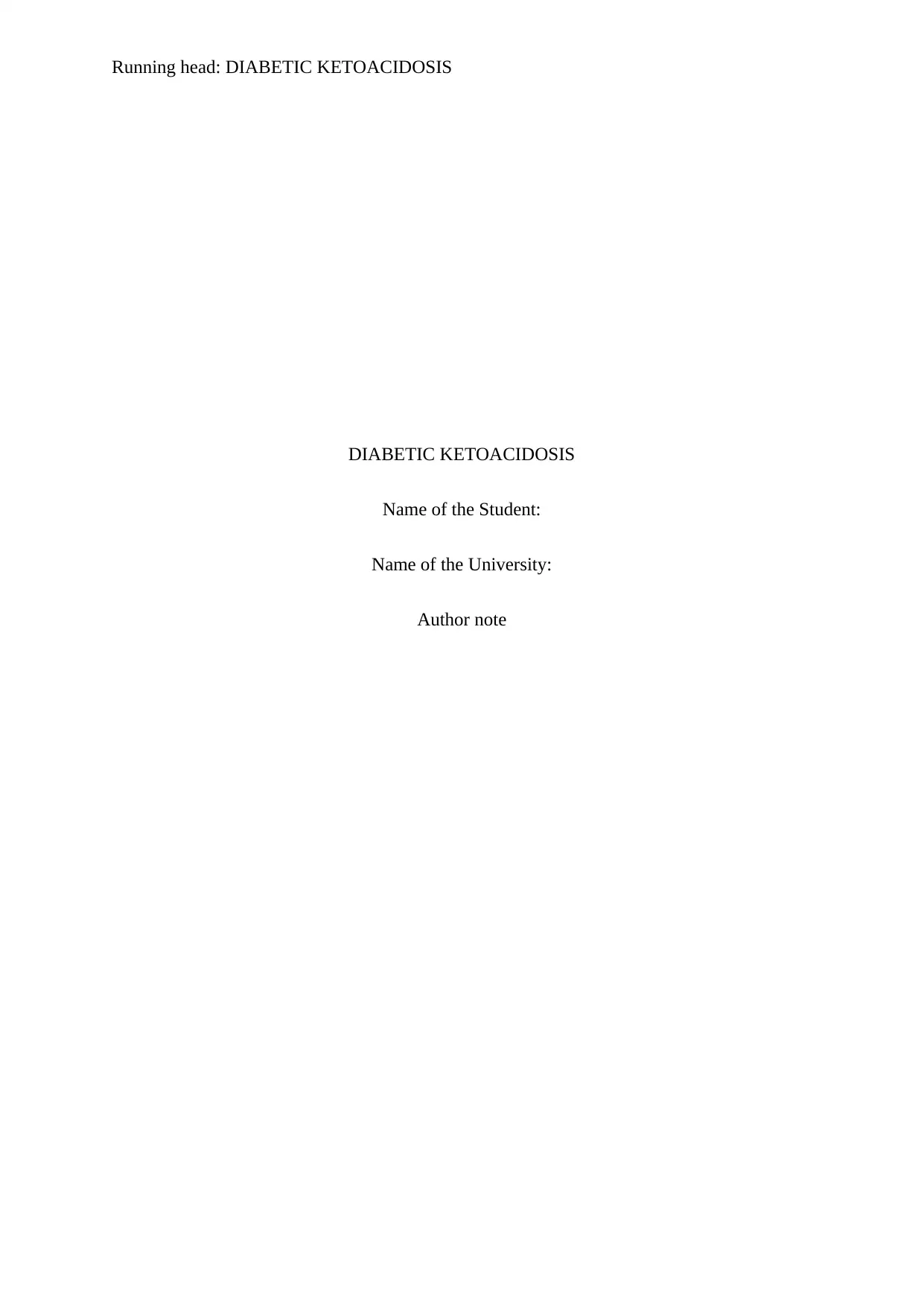
Running head: DIABETIC KETOACIDOSIS
DIABETIC KETOACIDOSIS
Name of the Student:
Name of the University:
Author note
DIABETIC KETOACIDOSIS
Name of the Student:
Name of the University:
Author note
Secure Best Marks with AI Grader
Need help grading? Try our AI Grader for instant feedback on your assignments.
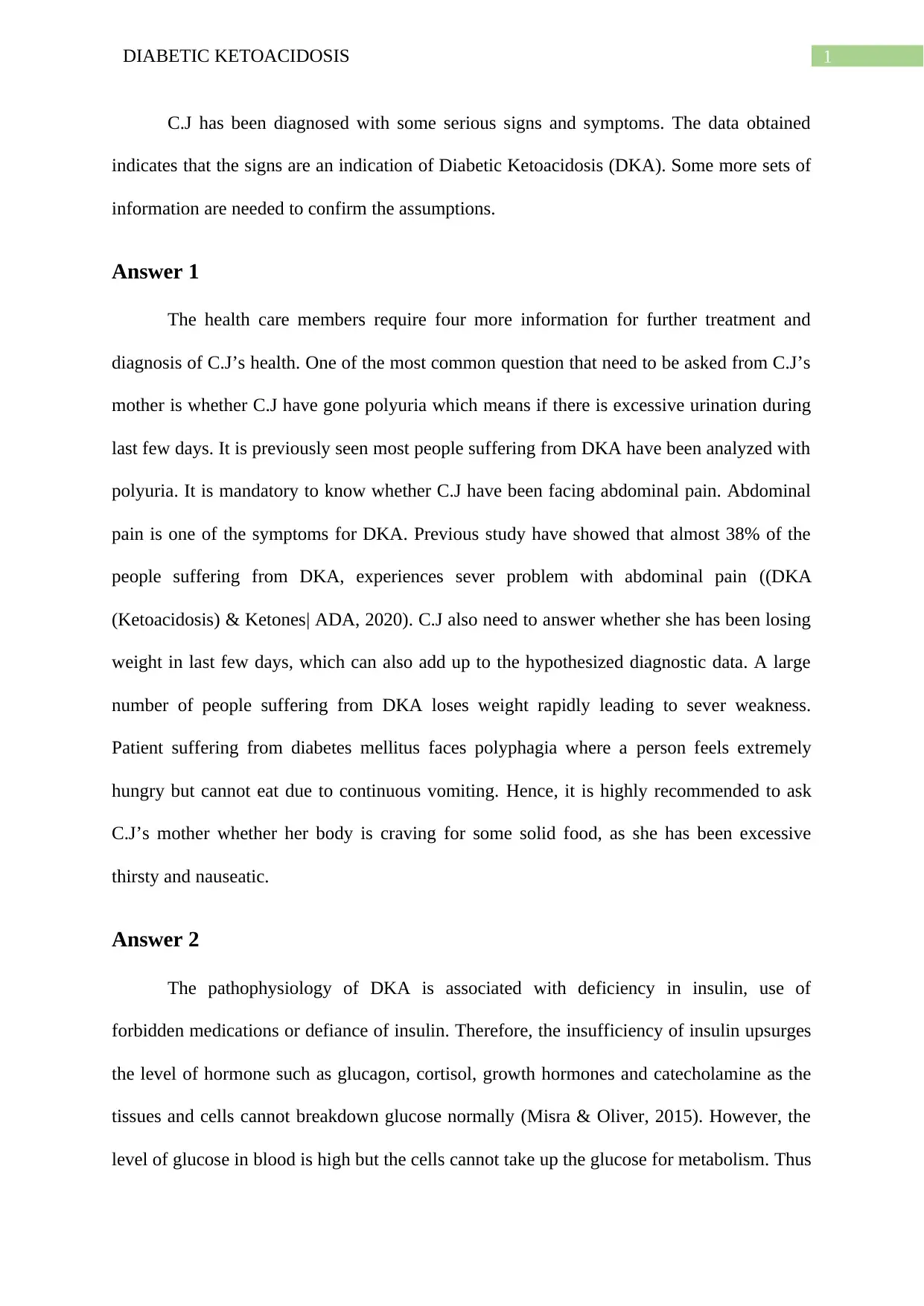
1DIABETIC KETOACIDOSIS
C.J has been diagnosed with some serious signs and symptoms. The data obtained
indicates that the signs are an indication of Diabetic Ketoacidosis (DKA). Some more sets of
information are needed to confirm the assumptions.
Answer 1
The health care members require four more information for further treatment and
diagnosis of C.J’s health. One of the most common question that need to be asked from C.J’s
mother is whether C.J have gone polyuria which means if there is excessive urination during
last few days. It is previously seen most people suffering from DKA have been analyzed with
polyuria. It is mandatory to know whether C.J have been facing abdominal pain. Abdominal
pain is one of the symptoms for DKA. Previous study have showed that almost 38% of the
people suffering from DKA, experiences sever problem with abdominal pain ((DKA
(Ketoacidosis) & Ketones| ADA, 2020). C.J also need to answer whether she has been losing
weight in last few days, which can also add up to the hypothesized diagnostic data. A large
number of people suffering from DKA loses weight rapidly leading to sever weakness.
Patient suffering from diabetes mellitus faces polyphagia where a person feels extremely
hungry but cannot eat due to continuous vomiting. Hence, it is highly recommended to ask
C.J’s mother whether her body is craving for some solid food, as she has been excessive
thirsty and nauseatic.
Answer 2
The pathophysiology of DKA is associated with deficiency in insulin, use of
forbidden medications or defiance of insulin. Therefore, the insufficiency of insulin upsurges
the level of hormone such as glucagon, cortisol, growth hormones and catecholamine as the
tissues and cells cannot breakdown glucose normally (Misra & Oliver, 2015). However, the
level of glucose in blood is high but the cells cannot take up the glucose for metabolism. Thus
C.J has been diagnosed with some serious signs and symptoms. The data obtained
indicates that the signs are an indication of Diabetic Ketoacidosis (DKA). Some more sets of
information are needed to confirm the assumptions.
Answer 1
The health care members require four more information for further treatment and
diagnosis of C.J’s health. One of the most common question that need to be asked from C.J’s
mother is whether C.J have gone polyuria which means if there is excessive urination during
last few days. It is previously seen most people suffering from DKA have been analyzed with
polyuria. It is mandatory to know whether C.J have been facing abdominal pain. Abdominal
pain is one of the symptoms for DKA. Previous study have showed that almost 38% of the
people suffering from DKA, experiences sever problem with abdominal pain ((DKA
(Ketoacidosis) & Ketones| ADA, 2020). C.J also need to answer whether she has been losing
weight in last few days, which can also add up to the hypothesized diagnostic data. A large
number of people suffering from DKA loses weight rapidly leading to sever weakness.
Patient suffering from diabetes mellitus faces polyphagia where a person feels extremely
hungry but cannot eat due to continuous vomiting. Hence, it is highly recommended to ask
C.J’s mother whether her body is craving for some solid food, as she has been excessive
thirsty and nauseatic.
Answer 2
The pathophysiology of DKA is associated with deficiency in insulin, use of
forbidden medications or defiance of insulin. Therefore, the insufficiency of insulin upsurges
the level of hormone such as glucagon, cortisol, growth hormones and catecholamine as the
tissues and cells cannot breakdown glucose normally (Misra & Oliver, 2015). However, the
level of glucose in blood is high but the cells cannot take up the glucose for metabolism. Thus
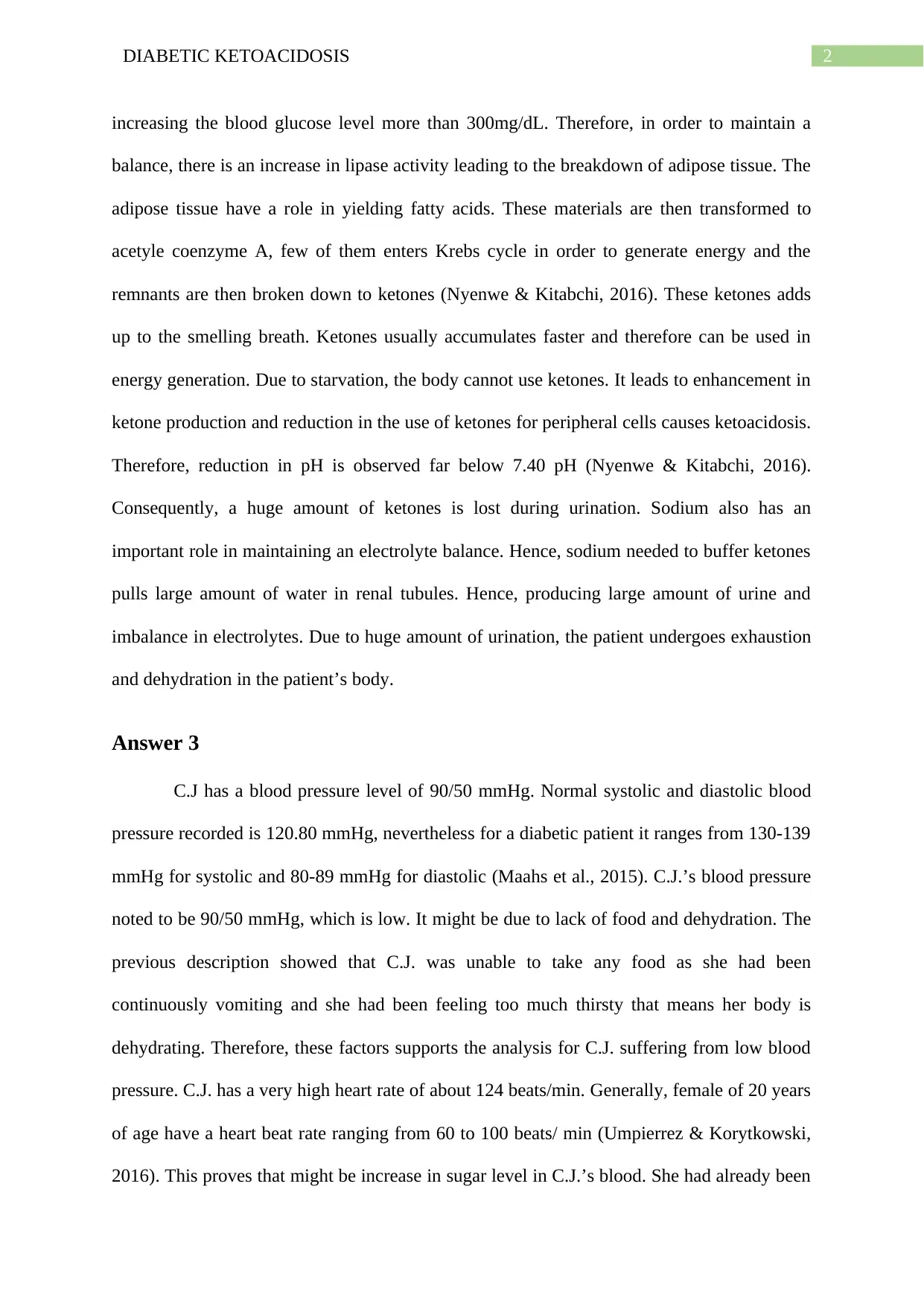
2DIABETIC KETOACIDOSIS
increasing the blood glucose level more than 300mg/dL. Therefore, in order to maintain a
balance, there is an increase in lipase activity leading to the breakdown of adipose tissue. The
adipose tissue have a role in yielding fatty acids. These materials are then transformed to
acetyle coenzyme A, few of them enters Krebs cycle in order to generate energy and the
remnants are then broken down to ketones (Nyenwe & Kitabchi, 2016). These ketones adds
up to the smelling breath. Ketones usually accumulates faster and therefore can be used in
energy generation. Due to starvation, the body cannot use ketones. It leads to enhancement in
ketone production and reduction in the use of ketones for peripheral cells causes ketoacidosis.
Therefore, reduction in pH is observed far below 7.40 pH (Nyenwe & Kitabchi, 2016).
Consequently, a huge amount of ketones is lost during urination. Sodium also has an
important role in maintaining an electrolyte balance. Hence, sodium needed to buffer ketones
pulls large amount of water in renal tubules. Hence, producing large amount of urine and
imbalance in electrolytes. Due to huge amount of urination, the patient undergoes exhaustion
and dehydration in the patient’s body.
Answer 3
C.J has a blood pressure level of 90/50 mmHg. Normal systolic and diastolic blood
pressure recorded is 120.80 mmHg, nevertheless for a diabetic patient it ranges from 130-139
mmHg for systolic and 80-89 mmHg for diastolic (Maahs et al., 2015). C.J.’s blood pressure
noted to be 90/50 mmHg, which is low. It might be due to lack of food and dehydration. The
previous description showed that C.J. was unable to take any food as she had been
continuously vomiting and she had been feeling too much thirsty that means her body is
dehydrating. Therefore, these factors supports the analysis for C.J. suffering from low blood
pressure. C.J. has a very high heart rate of about 124 beats/min. Generally, female of 20 years
of age have a heart beat rate ranging from 60 to 100 beats/ min (Umpierrez & Korytkowski,
2016). This proves that might be increase in sugar level in C.J.’s blood. She had already been
increasing the blood glucose level more than 300mg/dL. Therefore, in order to maintain a
balance, there is an increase in lipase activity leading to the breakdown of adipose tissue. The
adipose tissue have a role in yielding fatty acids. These materials are then transformed to
acetyle coenzyme A, few of them enters Krebs cycle in order to generate energy and the
remnants are then broken down to ketones (Nyenwe & Kitabchi, 2016). These ketones adds
up to the smelling breath. Ketones usually accumulates faster and therefore can be used in
energy generation. Due to starvation, the body cannot use ketones. It leads to enhancement in
ketone production and reduction in the use of ketones for peripheral cells causes ketoacidosis.
Therefore, reduction in pH is observed far below 7.40 pH (Nyenwe & Kitabchi, 2016).
Consequently, a huge amount of ketones is lost during urination. Sodium also has an
important role in maintaining an electrolyte balance. Hence, sodium needed to buffer ketones
pulls large amount of water in renal tubules. Hence, producing large amount of urine and
imbalance in electrolytes. Due to huge amount of urination, the patient undergoes exhaustion
and dehydration in the patient’s body.
Answer 3
C.J has a blood pressure level of 90/50 mmHg. Normal systolic and diastolic blood
pressure recorded is 120.80 mmHg, nevertheless for a diabetic patient it ranges from 130-139
mmHg for systolic and 80-89 mmHg for diastolic (Maahs et al., 2015). C.J.’s blood pressure
noted to be 90/50 mmHg, which is low. It might be due to lack of food and dehydration. The
previous description showed that C.J. was unable to take any food as she had been
continuously vomiting and she had been feeling too much thirsty that means her body is
dehydrating. Therefore, these factors supports the analysis for C.J. suffering from low blood
pressure. C.J. has a very high heart rate of about 124 beats/min. Generally, female of 20 years
of age have a heart beat rate ranging from 60 to 100 beats/ min (Umpierrez & Korytkowski,
2016). This proves that might be increase in sugar level in C.J.’s blood. She had already been
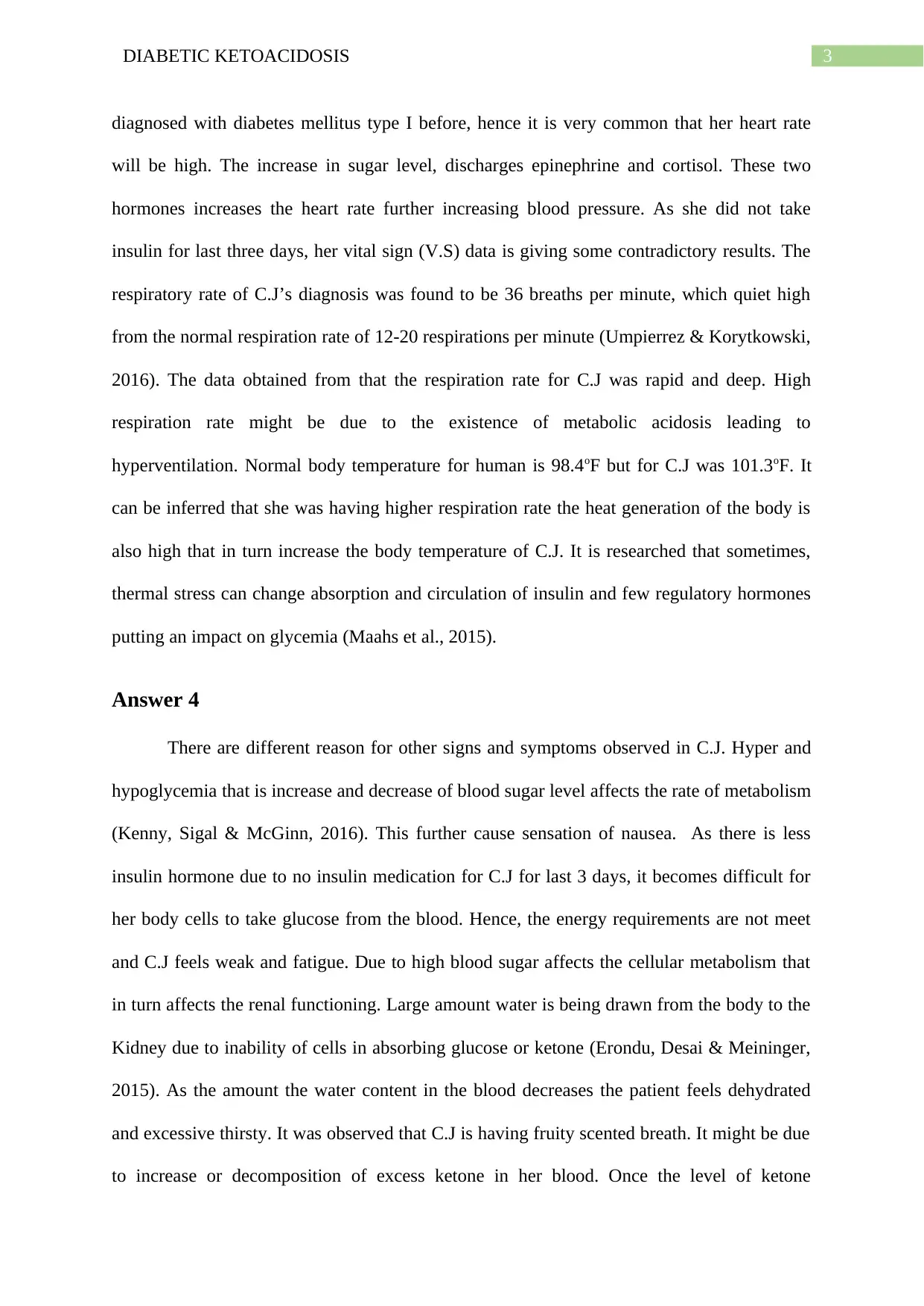
3DIABETIC KETOACIDOSIS
diagnosed with diabetes mellitus type I before, hence it is very common that her heart rate
will be high. The increase in sugar level, discharges epinephrine and cortisol. These two
hormones increases the heart rate further increasing blood pressure. As she did not take
insulin for last three days, her vital sign (V.S) data is giving some contradictory results. The
respiratory rate of C.J’s diagnosis was found to be 36 breaths per minute, which quiet high
from the normal respiration rate of 12-20 respirations per minute (Umpierrez & Korytkowski,
2016). The data obtained from that the respiration rate for C.J was rapid and deep. High
respiration rate might be due to the existence of metabolic acidosis leading to
hyperventilation. Normal body temperature for human is 98.4oF but for C.J was 101.3oF. It
can be inferred that she was having higher respiration rate the heat generation of the body is
also high that in turn increase the body temperature of C.J. It is researched that sometimes,
thermal stress can change absorption and circulation of insulin and few regulatory hormones
putting an impact on glycemia (Maahs et al., 2015).
Answer 4
There are different reason for other signs and symptoms observed in C.J. Hyper and
hypoglycemia that is increase and decrease of blood sugar level affects the rate of metabolism
(Kenny, Sigal & McGinn, 2016). This further cause sensation of nausea. As there is less
insulin hormone due to no insulin medication for C.J for last 3 days, it becomes difficult for
her body cells to take glucose from the blood. Hence, the energy requirements are not meet
and C.J feels weak and fatigue. Due to high blood sugar affects the cellular metabolism that
in turn affects the renal functioning. Large amount water is being drawn from the body to the
Kidney due to inability of cells in absorbing glucose or ketone (Erondu, Desai & Meininger,
2015). As the amount the water content in the blood decreases the patient feels dehydrated
and excessive thirsty. It was observed that C.J is having fruity scented breath. It might be due
to increase or decomposition of excess ketone in her blood. Once the level of ketone
diagnosed with diabetes mellitus type I before, hence it is very common that her heart rate
will be high. The increase in sugar level, discharges epinephrine and cortisol. These two
hormones increases the heart rate further increasing blood pressure. As she did not take
insulin for last three days, her vital sign (V.S) data is giving some contradictory results. The
respiratory rate of C.J’s diagnosis was found to be 36 breaths per minute, which quiet high
from the normal respiration rate of 12-20 respirations per minute (Umpierrez & Korytkowski,
2016). The data obtained from that the respiration rate for C.J was rapid and deep. High
respiration rate might be due to the existence of metabolic acidosis leading to
hyperventilation. Normal body temperature for human is 98.4oF but for C.J was 101.3oF. It
can be inferred that she was having higher respiration rate the heat generation of the body is
also high that in turn increase the body temperature of C.J. It is researched that sometimes,
thermal stress can change absorption and circulation of insulin and few regulatory hormones
putting an impact on glycemia (Maahs et al., 2015).
Answer 4
There are different reason for other signs and symptoms observed in C.J. Hyper and
hypoglycemia that is increase and decrease of blood sugar level affects the rate of metabolism
(Kenny, Sigal & McGinn, 2016). This further cause sensation of nausea. As there is less
insulin hormone due to no insulin medication for C.J for last 3 days, it becomes difficult for
her body cells to take glucose from the blood. Hence, the energy requirements are not meet
and C.J feels weak and fatigue. Due to high blood sugar affects the cellular metabolism that
in turn affects the renal functioning. Large amount water is being drawn from the body to the
Kidney due to inability of cells in absorbing glucose or ketone (Erondu, Desai & Meininger,
2015). As the amount the water content in the blood decreases the patient feels dehydrated
and excessive thirsty. It was observed that C.J is having fruity scented breath. It might be due
to increase or decomposition of excess ketone in her blood. Once the level of ketone
Secure Best Marks with AI Grader
Need help grading? Try our AI Grader for instant feedback on your assignments.
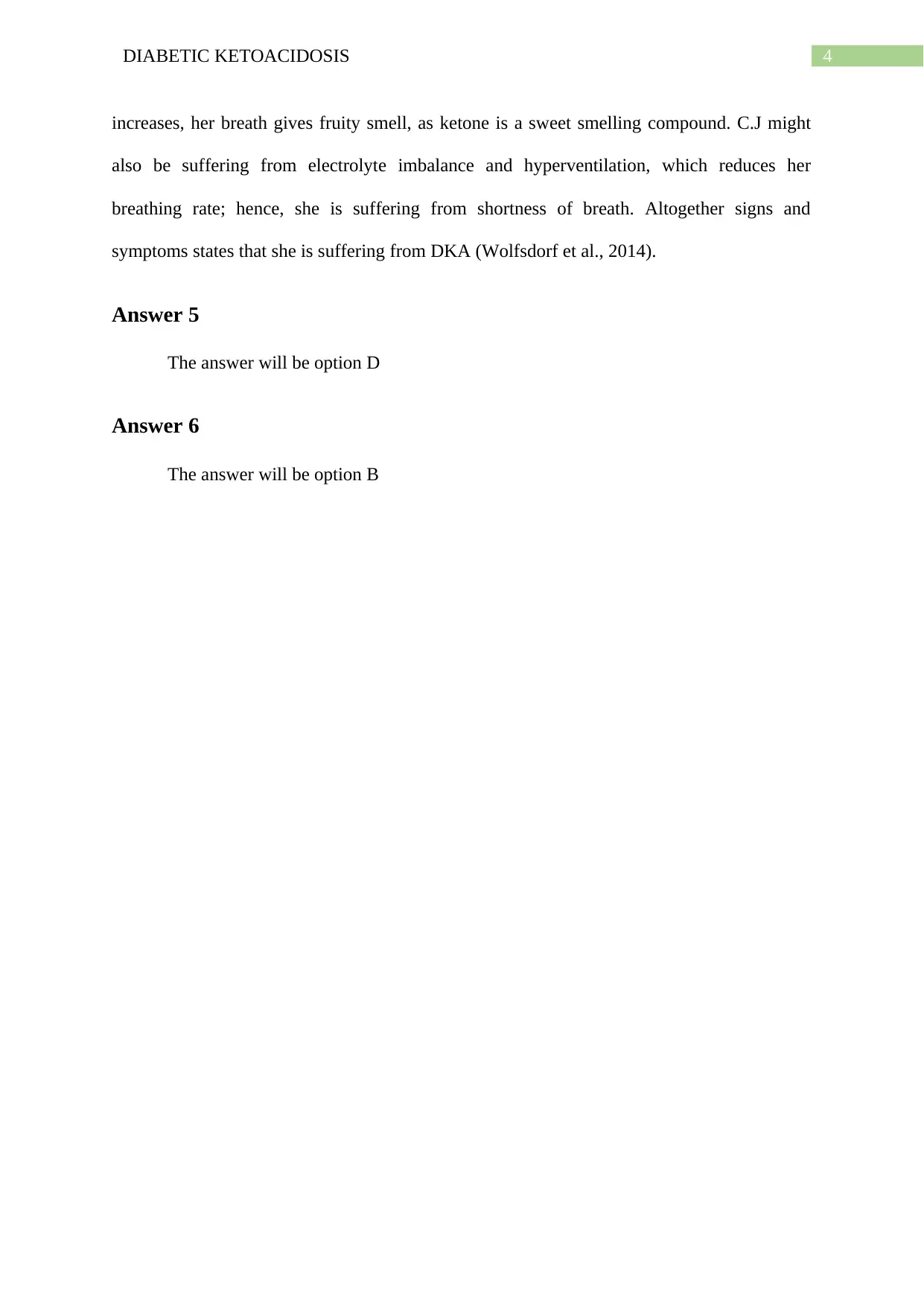
4DIABETIC KETOACIDOSIS
increases, her breath gives fruity smell, as ketone is a sweet smelling compound. C.J might
also be suffering from electrolyte imbalance and hyperventilation, which reduces her
breathing rate; hence, she is suffering from shortness of breath. Altogether signs and
symptoms states that she is suffering from DKA (Wolfsdorf et al., 2014).
Answer 5
The answer will be option D
Answer 6
The answer will be option B
increases, her breath gives fruity smell, as ketone is a sweet smelling compound. C.J might
also be suffering from electrolyte imbalance and hyperventilation, which reduces her
breathing rate; hence, she is suffering from shortness of breath. Altogether signs and
symptoms states that she is suffering from DKA (Wolfsdorf et al., 2014).
Answer 5
The answer will be option D
Answer 6
The answer will be option B
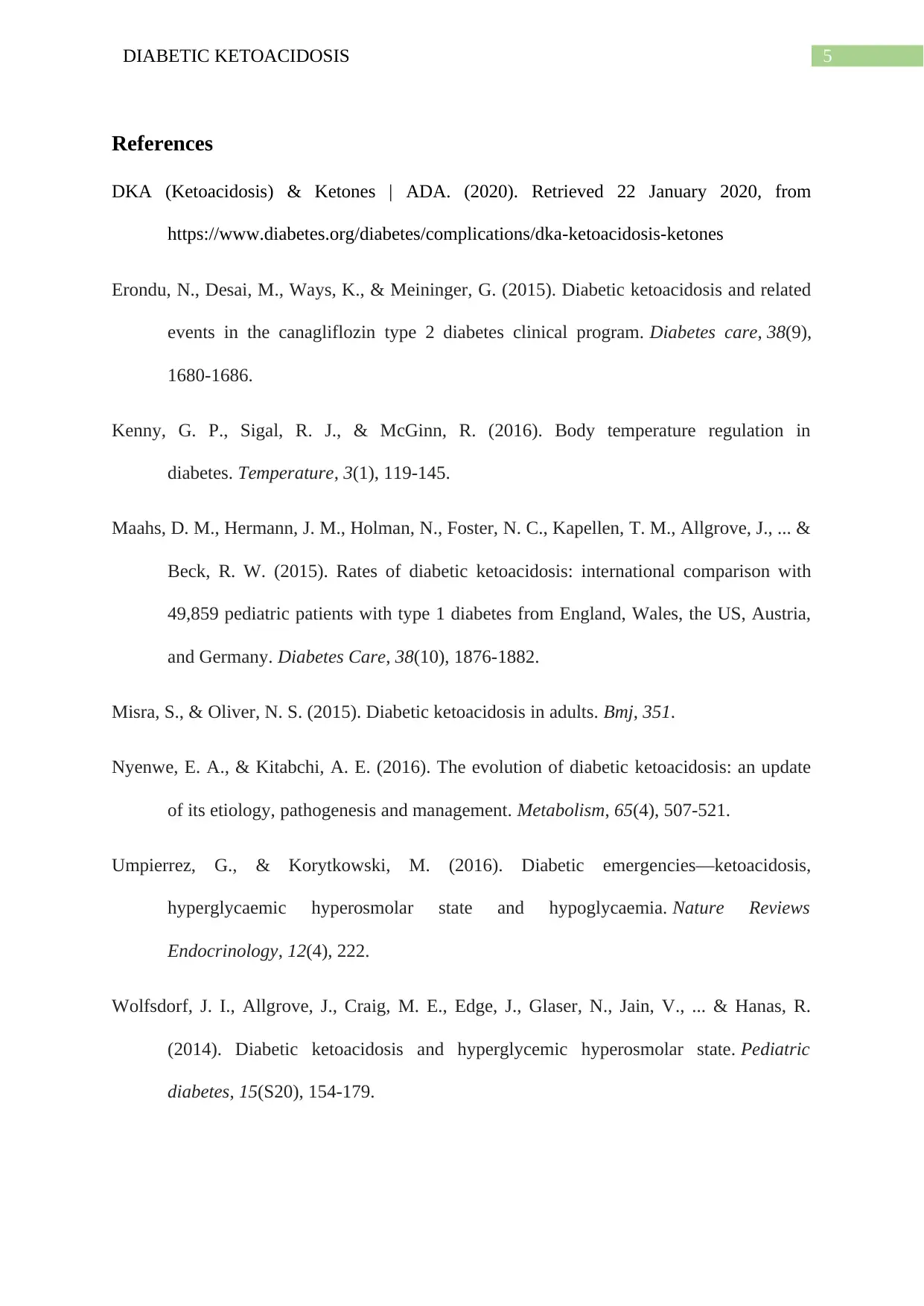
5DIABETIC KETOACIDOSIS
References
DKA (Ketoacidosis) & Ketones | ADA. (2020). Retrieved 22 January 2020, from
https://www.diabetes.org/diabetes/complications/dka-ketoacidosis-ketones
Erondu, N., Desai, M., Ways, K., & Meininger, G. (2015). Diabetic ketoacidosis and related
events in the canagliflozin type 2 diabetes clinical program. Diabetes care, 38(9),
1680-1686.
Kenny, G. P., Sigal, R. J., & McGinn, R. (2016). Body temperature regulation in
diabetes. Temperature, 3(1), 119-145.
Maahs, D. M., Hermann, J. M., Holman, N., Foster, N. C., Kapellen, T. M., Allgrove, J., ... &
Beck, R. W. (2015). Rates of diabetic ketoacidosis: international comparison with
49,859 pediatric patients with type 1 diabetes from England, Wales, the US, Austria,
and Germany. Diabetes Care, 38(10), 1876-1882.
Misra, S., & Oliver, N. S. (2015). Diabetic ketoacidosis in adults. Bmj, 351.
Nyenwe, E. A., & Kitabchi, A. E. (2016). The evolution of diabetic ketoacidosis: an update
of its etiology, pathogenesis and management. Metabolism, 65(4), 507-521.
Umpierrez, G., & Korytkowski, M. (2016). Diabetic emergencies—ketoacidosis,
hyperglycaemic hyperosmolar state and hypoglycaemia. Nature Reviews
Endocrinology, 12(4), 222.
Wolfsdorf, J. I., Allgrove, J., Craig, M. E., Edge, J., Glaser, N., Jain, V., ... & Hanas, R.
(2014). Diabetic ketoacidosis and hyperglycemic hyperosmolar state. Pediatric
diabetes, 15(S20), 154-179.
References
DKA (Ketoacidosis) & Ketones | ADA. (2020). Retrieved 22 January 2020, from
https://www.diabetes.org/diabetes/complications/dka-ketoacidosis-ketones
Erondu, N., Desai, M., Ways, K., & Meininger, G. (2015). Diabetic ketoacidosis and related
events in the canagliflozin type 2 diabetes clinical program. Diabetes care, 38(9),
1680-1686.
Kenny, G. P., Sigal, R. J., & McGinn, R. (2016). Body temperature regulation in
diabetes. Temperature, 3(1), 119-145.
Maahs, D. M., Hermann, J. M., Holman, N., Foster, N. C., Kapellen, T. M., Allgrove, J., ... &
Beck, R. W. (2015). Rates of diabetic ketoacidosis: international comparison with
49,859 pediatric patients with type 1 diabetes from England, Wales, the US, Austria,
and Germany. Diabetes Care, 38(10), 1876-1882.
Misra, S., & Oliver, N. S. (2015). Diabetic ketoacidosis in adults. Bmj, 351.
Nyenwe, E. A., & Kitabchi, A. E. (2016). The evolution of diabetic ketoacidosis: an update
of its etiology, pathogenesis and management. Metabolism, 65(4), 507-521.
Umpierrez, G., & Korytkowski, M. (2016). Diabetic emergencies—ketoacidosis,
hyperglycaemic hyperosmolar state and hypoglycaemia. Nature Reviews
Endocrinology, 12(4), 222.
Wolfsdorf, J. I., Allgrove, J., Craig, M. E., Edge, J., Glaser, N., Jain, V., ... & Hanas, R.
(2014). Diabetic ketoacidosis and hyperglycemic hyperosmolar state. Pediatric
diabetes, 15(S20), 154-179.

6DIABETIC KETOACIDOSIS
1 out of 7
Related Documents
Your All-in-One AI-Powered Toolkit for Academic Success.
+13062052269
info@desklib.com
Available 24*7 on WhatsApp / Email
![[object Object]](/_next/static/media/star-bottom.7253800d.svg)
Unlock your academic potential
© 2024 | Zucol Services PVT LTD | All rights reserved.





